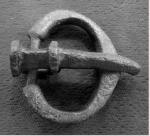Summary (English)
EXPLORATIONS IN MESAMBRIA (Petya Kiyashkina – kiyashkina_p@abv.bg, Todor Marvakov, Stoyanka Dimova) The necropolis was used from the end of the 4th century BC to the 19th century and 291 graves were explored: 59 Hellenistic graves from the 3rd – 2nd centuries BC, 73 Early Byzantine graves from the 5th – 7th centuries AD, 95 Mediaeval Christian graves from the 8th – 12th centuries, 20 Late Mediaeval Christian graves from the 15th – 16th centuries and 44 Muslim graves from the 17th – 19th centuries. The Hellenistic graves were three types: cist graves, graves covered with roof-tiles and burial pits. The funerary ritual was inhumation. Most graves contained a ritually broken ceramic jug. Cist grave No. 71 contained a funerary wreath, an arrowhead and a posthumous drachma of Alexander the Great. Most graves were burial pits with different orientations. The deceased were rested in wooden coffins. The grave goods include unguentaria, Charon’s obols (all types of bronze coins minted by Mesambria from the end of the 4th to the end of the 2nd century BC), necklaces of glass beads, funerary wreaths, molded relief bowls, small dishes and kantharoi. Gold earrings of the 2nd century BC were found in graves Nos. 124 and 125. The first type of the Early Byzantine graves was constructed of stone slabs or uneven stones. A Hellenistic funerary stele with the names of two brothers: Lysis and Moschos, the sons of Lysis, was reused in grave No. 193. The second type was rectangular burial pits, most of them covered with wooden boards. The grave goods include five belt buckles of the second half of the 5th – first half of the 6th centuries AD, a belt buckle of the Balgota type of the 7th century AD and three necklaces of color glass beads. The grave goods from the Mediaeval graves include finger-rings and earrings of the 9th – 10th centuries, a necklace of glass beads and an arrowhead. The deceased buried in the Late Mediaeval graves probably had died in a short period during an epidemic or a war. The grave goods include small crosses and buttons.
- Petya Kiyashkina - ‘Old Nesebar’ Museum
- Todor Marvakov - ‘Old Nesebar’ Museum
- Stoyanka Dimova - ‘Old Nesebar’ Museum
Director
Team
Research Body
- ‘Old Nesebar’ Museum






![Download [PDF]](/excavation/skins/fasti/images/results/download_sml.png)